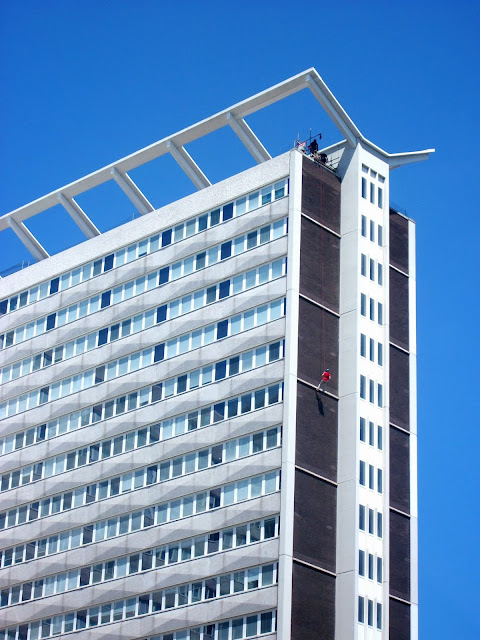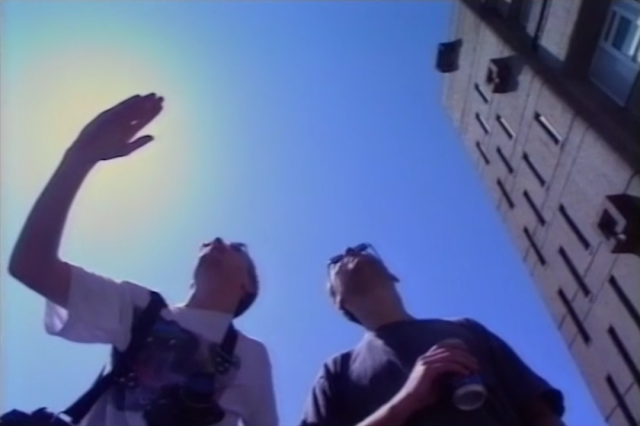James Bolam: Modernist Prophet
Whenever I think of postwar modernism I think of James Bolam. Sort of. Here's three reasons why.
Firstly, here's the opening titles of Whatever Happened to the Likely Lads? featuring the demolition and rebuilding of Newcastle, including the towers of Cruddas Park rising above the bulldozed wasteland of the city. The song has a rousingly nostalgic tone, setting the scene. Bob has moved into a classic New Town-style newbuild house, representing how he's broken with the past and has become upwardly mobile, white Terry (Bolam) remains adamantly wedded to his working class roots.
From the mid-eighties, here's a piece from peerless comedy drama The Beiderbecke Affair by the wonderful Alan Plater. Beautifully filmed, much of the school scenes were done in long shot through the glass walls, usually with either a deadpan Bolam-Flynn voice-over, or jaunty Beiderbecke jazz. Here's a typically delightful and stylish segment from the first episode.
Lastly, there's a fantastic documentary from the newly born Channel Four in 1982 called The Sixties, before the channel turned into lifestyle porn and 'reality' cruelty. Narrated in characterful fashion by James Bolam, this episode The Getaway People tells the story of postwar rebuilding and features interviews with ageing hipster Reyner Banham, patrician traffic guru Colin Buchanan, soulful Alison Ravetz bemoaning the destruction of the old city fabric, and incisive planning expert Peter Hall, speaking about systems in the manner of Adam Curtis. The documentary's aim, as in so much of the eighties, is to dismantle the dreams of the 1960s, in this case the planners and architects, particularly the transport planners. Here we have Buchanan's Traffic in Towns report taken weirdly literally, considering how it appeared to be half-warning how crazy the destruction of towns for the car could be. Leeds gets it in the neck, as it usually does in discussions about sixties planning, with fascinating interviews with two former Lord Mayors of Leeds discussing the pressures on them from the governments of the day. And, naturally, the arrival of systems built high rise blocks crashes into the programme like a ton of concrete, with an amazing Sectra ad and footage from the time of Ronan Point. The footage and interviews are completely brilliant, it's a must-see.
Firstly, here's the opening titles of Whatever Happened to the Likely Lads? featuring the demolition and rebuilding of Newcastle, including the towers of Cruddas Park rising above the bulldozed wasteland of the city. The song has a rousingly nostalgic tone, setting the scene. Bob has moved into a classic New Town-style newbuild house, representing how he's broken with the past and has become upwardly mobile, white Terry (Bolam) remains adamantly wedded to his working class roots.
From the mid-eighties, here's a piece from peerless comedy drama The Beiderbecke Affair by the wonderful Alan Plater. Beautifully filmed, much of the school scenes were done in long shot through the glass walls, usually with either a deadpan Bolam-Flynn voice-over, or jaunty Beiderbecke jazz. Here's a typically delightful and stylish segment from the first episode.
Lastly, there's a fantastic documentary from the newly born Channel Four in 1982 called The Sixties, before the channel turned into lifestyle porn and 'reality' cruelty. Narrated in characterful fashion by James Bolam, this episode The Getaway People tells the story of postwar rebuilding and features interviews with ageing hipster Reyner Banham, patrician traffic guru Colin Buchanan, soulful Alison Ravetz bemoaning the destruction of the old city fabric, and incisive planning expert Peter Hall, speaking about systems in the manner of Adam Curtis. The documentary's aim, as in so much of the eighties, is to dismantle the dreams of the 1960s, in this case the planners and architects, particularly the transport planners. Here we have Buchanan's Traffic in Towns report taken weirdly literally, considering how it appeared to be half-warning how crazy the destruction of towns for the car could be. Leeds gets it in the neck, as it usually does in discussions about sixties planning, with fascinating interviews with two former Lord Mayors of Leeds discussing the pressures on them from the governments of the day. And, naturally, the arrival of systems built high rise blocks crashes into the programme like a ton of concrete, with an amazing Sectra ad and footage from the time of Ronan Point. The footage and interviews are completely brilliant, it's a must-see.










Fascinating programme that, some great footage. I've studied Hunslet Grange and hadn't realised just how huge a project it was until I saw it on film. Frank Marshall and Albert King were Leeds council leaders rather than Lord Mayors, not difficult to tell which was Tory and which Labour in those days!
ReplyDeleteAh yes, I beg their pardon, council leaders it was. What did your studies on Hunslet Grange reveal?
DeleteNow this (Likely Lads intro) is a great find for the history of Cruddas Park - working around the area and dealing with retrofitting and demolitions. Reminds me of another famous North East architectural icon ... http://studiourbanarea.blogspot.co.uk/2013/09/dunston-rocket.html ... appearing in the Tudor Crisps advert.
ReplyDeleteThat is a FANTASTIC ad!
DeleteTHE SIXTIES was broadcast as a six-part series during the opening weeks of Channel Four in 1982. The opening episode was called 'Queen Victoria died in 1960' and considered the origins of the social/cultural revolution between 1956 and 1963, including Rock n' Roll, CND, The Chatterley Trial, the Satire boom, the Profumo affair, the beginning of the end of defence, the demise of the Tory government and the rise of Harold Wilson. Apart from 'Getaway People' the other episodes dealt with the youth revolution, The sexual/moral revolution, the evolving politics, including gay liberation and feminism. The concluding episode called 'whose revolution?' considered the contested legacy of the decade. Talking heads included sociologist Stuart Hall, Jeff Banks, Spike Milligan and George Melly. The series attempted a revisionist analysis of the decade and was part of an generally negative eighties re-interpretation of the legacy of the period. An accompanying book THE SIXTIES: A FRESH LOOK AT THE DECADE OF CHANGE by a young Francis Wheen also adopted this thematic approach and is still one of the best accounts of the decade. Unfortunately 'Getaway People' is the only existing episode on Youtube, though apparently Brighton University holds the entire series on VHS tape in its library.
ReplyDelete